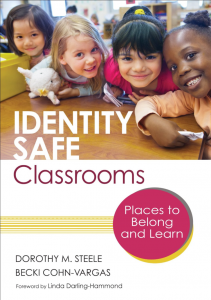This blog post first appeared in Road Trips in Education at EdWeek Teacher, June 19, 2015.
 There is no debate that children deserve safe schools where they are valued as people and fully supported as learners. However, not all of the obstacles that undermine the sense of safety are obvious, and without recognizing them, we cannot address them as effectively. In their book Identity Safe Classrooms: Places to Belong and Learn, Dorothy M. Steele and Becki Cohn-Vargas provide educators with a better understanding of what identity safety means, why it matters at school, and what teachers can do to ensure that our campuses and classrooms are conducive to learning for every student. Drawing on their own research, along with a broader body of research in education and psychology, and illustrative examples from teachers and schools, Steele and Cohn-Vargas advance an important discussion in education in while offering practical ways for teachers and school staff to improve learning environments.
There is no debate that children deserve safe schools where they are valued as people and fully supported as learners. However, not all of the obstacles that undermine the sense of safety are obvious, and without recognizing them, we cannot address them as effectively. In their book Identity Safe Classrooms: Places to Belong and Learn, Dorothy M. Steele and Becki Cohn-Vargas provide educators with a better understanding of what identity safety means, why it matters at school, and what teachers can do to ensure that our campuses and classrooms are conducive to learning for every student. Drawing on their own research, along with a broader body of research in education and psychology, and illustrative examples from teachers and schools, Steele and Cohn-Vargas advance an important discussion in education in while offering practical ways for teachers and school staff to improve learning environments.
Discussions of classroom practice typically focus on curriculum and instruction, and gathering evidence of learning. Obviously those are integral to our profession, but it does seem that we neglect some of the foundational concerns that either enable or inhibit learning in the first place. Certainly we need teachers who understand and utitlize a variety of instructional strategies to support reading and writing, historic and scientific inquiry, language acquisition, the arts and physical education. But in any class or discipline, optimal learning conditions depend on students comfort and safety. The authors note:
Often people talk about social and emotional learning as an add-on, but we cannot overstate the strength of the link between students’ sense of belonging and their ability to focus on learning unencumbered by worries that their social identity will become a barrier to academic success. Having a sense of belonging is a condition for learning that must be met for all students, no matter what their background. (197)
Children aren’t so different from adults in needing the right conditions to do our best, and for adults, we have clearly articulated legal rights in the workplace. Here’s some language from the U.S. Equal Employment Opportunity Commission web page on harrassment:
To be unlawful, the conduct must create a work environment that would be intimidating, hostile, or offensive to reasonable people.Offensive conduct may include, but is not limited to, offensive jokes, slurs, epithets or name calling, physical assaults or threats, intimidation, ridicule or mockery, insults or put-downs, offensive objects or pictures, and interference with work performance. Harassment can occur in a variety of circumstances, including, but not limited to, the following:
- The harasser can be the victim’s supervisor, a supervisor in another area, an agent of the employer, a co-worker, or a non-employee.
- The victim does not have to be the person harassed, but can be anyone affected by the offensive conduct.
While I don’t always advise thinking of schools as children’s workplaces, it might help in this regard. The law focuses on the “environment,” specifies multiple potential sources of harassment, and protects “anyone affected.” So as a starting point, we would do well to make sure that children have minimally this level of safety and “workplace” rights. Identity Safe Classrooms does explore issues of stereotypes and hurtful language and actions, and I expect we have a long way to go as a country before teachers are universally willing and able to intervene effectively whenever there are clear incidents of harassment or discrimination. However, I think the main value of the book is in providing proactive, prosocial ways for educators to improve the learning climate.
Some of the advice in the book might at first glance appear to be focused merely on student engagement and a positive classroom atmosphere: there are suggestions for establishing relationships, fostering student voice and autonomy, building a collaborative culture, providing for student comfort, and valuing diversity. However, students and teachers all bring certain biases and blind spots to the classroom, and there ways to recognize and address these issues so that all students are able to bring their authentic selves to their educational experience. I can relate to students’ needs in this area in part because of experiences as a Jewish student. Christmas and Easter were assumed to be part of students’ lives, and the occasional reference to Hannukah was often botched by labeling it the “Jewish Christmas.” I also recall some teachers’ reactions when I informed them I would be missing school due to the observance of the Jewish High Holy Days. I sometimes felt that teachers subconsciously weighed their lesson plans against my religious practices, and in their responses to me subtly implied that my priorities were questionable. Still, in every other regard I benefitted from being part of the majority and the mainstream, and so I carried my own biases into my teaching, and continually try to recognize and correct them as needed. For example, I can’t imagine how many times, early in my career, I talked about families generally in terms of mothers and fathers, unintentionally marginalizing children of single parents, same-sex parents, foster families, multi-generational and blended families.
In an identity safe classroom, a teacher makes an effort to know students well and to see their varied identities as assets, ways to access a wider understanding of people, communities, and experiences. The curriculum, activities, and class discussions are varied as well, providing opportunities for all students to connect with the content, the instructor, and their peers. There’s an effort to go beyond superficial or token engagement: Cohn-Vargas observes, “more than one African American parent has pointed out to me how year after year their children study Dr. Martin Luther King’s ‘I have a Dream’ speech, asking why teachers can’t go beyond it to the rich traditions of African American literature” (74).
It’s also important to note the complexity of identity, comprised of ethnic, cultural, geographic, economic, national, linguistic, religious, familial, physical and developmental characteristics, and a whole panoply of experiences, dispositions, affiliations, interests, tastes, and skills. An educator could choose to be overwhelmed by this complexity and try to avoid sensitive issues, multiple perspectives, any hint of controversy or discomfort. The authors advise that in a sense, avoiding these topics is a way of teaching something about them – that they are unworthy of our time and consideration. They also note that because of this complexity, “A feeling of identity safety is not a permanent condition, but one that may change, depending on the characteristics of the situation” (132). I find that idea motivating, as it removes any pretense of being able to finish the work (you can’t just teach a unit on identity safety and move on), and instead invites the effort improve over time, to create new learning situations where more students have more positive experiences.
I do have one caveat for potential readers: while much of the cited research suggests applicability in high school and college, the practical focus of the book is mainly on elementary and middle grades. I’m comfortable making adjustments on my own as I read, considering how differences in context might be relevant to the examples and advice in the book. And in some cases, the exact same practices will work with different age groups. I’m thinking here of a classroom I visited earlier this spring.
Mangla Oza teaches fifth grade at Duveneck Elementary School in Palo Alto, CA, (part of my school district), and I was visiting her class at the suggestion of the book’s co-author Becki Cohn-Vargas, a former administrator in our district. To start off each class, Oza holds a class meeting, which helps everyone in the class know each other and feel comfortable discussing a variety of subjects. There are topics or themes for the day, but also opportunity to simply share a comment or question. The class proceeds with a sense of purpose and energy, but also a sense of calm order. In small group conversations about literature, everyone seemed to participate quite evenly, without direct monitoring or provided structure. One particular techique that promoted identity safety and would work at the high school level was questioning rather than praising student comments and answers. During discussions, Oza did not ask questions with quick, obvious correct answers. And when students responded, the typical follow up was, “How do you know?” or “Why do you think so?” Using this approach, Oza addresses multiple goals, helping students understand the connections between details and main ideas, text and inference. The conversation is more about thinking and learning, less about having the correct answer immediately. Students who are grasping the concepts more easily receive no more or less praise than those who are still trying to work out the ideas and doing so publicly. In this case, techniques that help fifth graders would translate easily and directly to classrooms at other grade levels. Identity Safe Classrooms has other examples and advice that make the book worth a read for any teacher or those who work with teachers.

